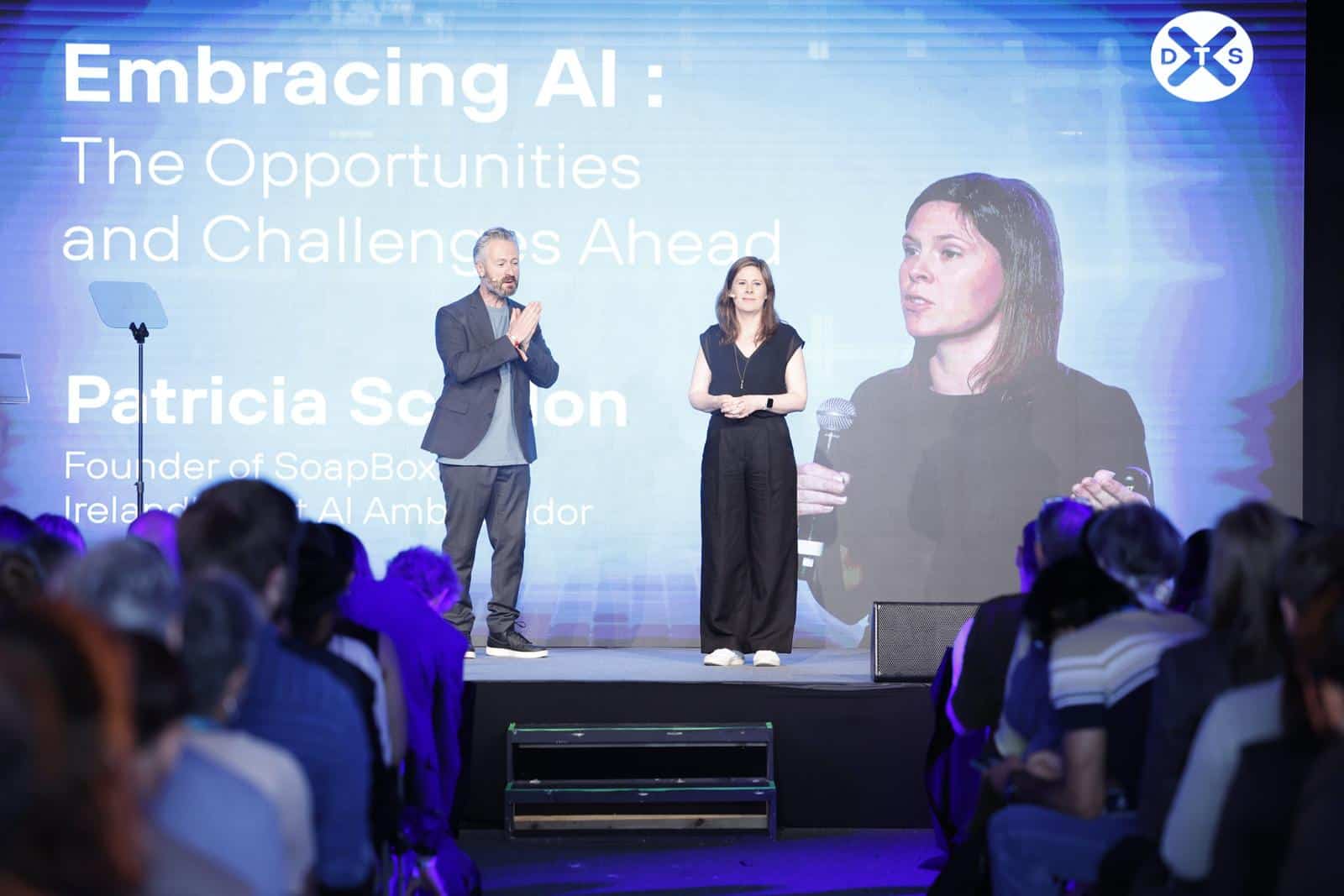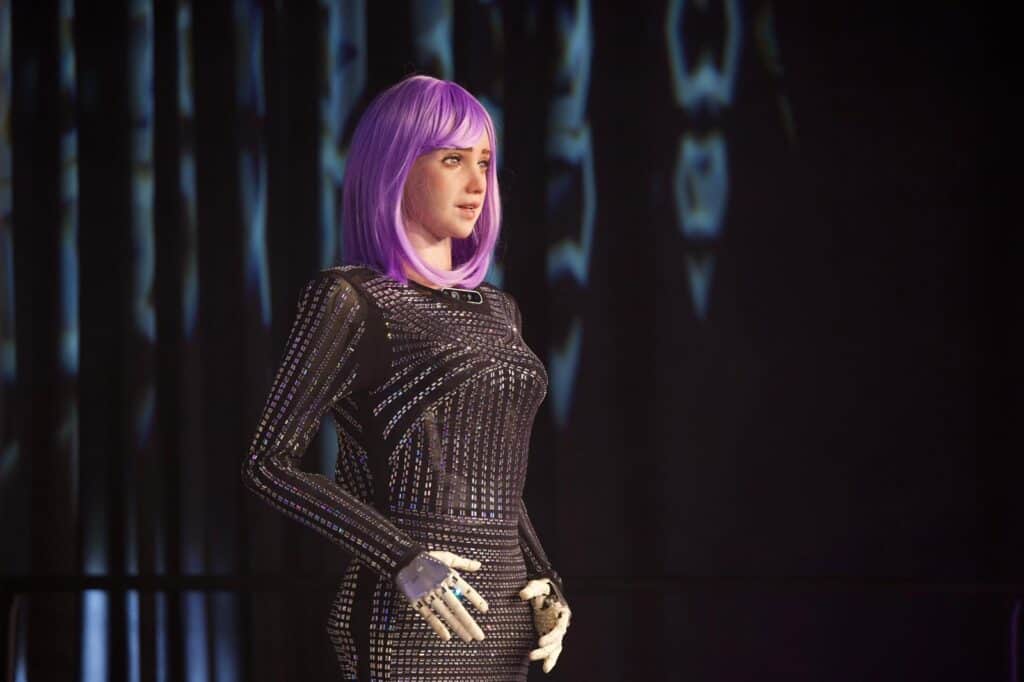Pictured: Desdemona the robot on the Prism stage at Dublin Tech Summit 2023. Picture by Andres Poveda.
Dublin Tech Summit 2023 boasted 8,000 attendees, with 70 nationalities represented from across the globe. The Prism stage hosted insightful conversations on AI, smart cities, magic, and more.
The seventh iteration of Dublin Tech Summit, ‘Europe’s fastest growing tech festival’, took place in the RDS on May 31st and June 1st this year. In total, 8,000 attendees were treated to two days of networking, pitching, and panel discussions focused on the fast-changing world of technology.
The Prism stage was set up in a tent at the back of the RDS, which attendees could enter from the main hall.
Embracing AI
The first day on the Prism stage started with an address from moderator Oisin Lunny, who introduced Dr. Patricia Scanlon, Ireland’s First AI Ambassador, and Founder and Executive Chair of SoapBox Labs.
Dr. Scanlon spoke to attendees in a keynote on the topic of the moment: AI. Titled ‘Embracing AI – the opportunities and challenges ahead,’ Dr. Scanlon noted that AI poses an existential threat, and “it’s up to us to regulate it.”
“Regulation can build good technology […] everybody is calling for this now,” she said. “Harmonisation globally […] is good for all of us.”
She discussed the uses of AI in the medical field, such as its potential in aiding the development of antibody super-drugs and accelerated drug delivery.
Calling AI a ‘revolution’, she said with regard to job losses as a result of mass AI adoption, that this happens with every revolution.
“We do need upskilling and transferrable skills to the AI space, it doesn’t have to be technology,” she said.

Pictured (L-R): Oisin Lunny, Prism stage moderator, and Dr. Patricia Scanlon, SoapBox Labs. Picture by Andres Poveda.
Driving DE&I
Shinjini Das, of Das Media Group, guided a panel on the subject of ‘Leading the Way: Women in Tech Driving DE&I Solutions.’
She was joined by Anna Brailsford, CEO, Code First Girls, Mary-Christine Nolan, VP of Global Professional Services, Pluralsight, Ruth Thomas, Head of People & Organisational Development, Personio, and Bríd McMahon, Country Manager IAS Ireland & VP, Technical Customer Operations, EMEA, Integral Ad Science.
Nolan stated during the panel that there will be 10 million roles unfilled in tech by 2030 if action is not taken now. McMahon suggested removing ‘jargon’ from job descriptions and reaching out to people before they enter the workforce.
Large Language Models
After lunch on day one, Dr. Ben Goertzel, CEO and founder, SingularityNET, discussed ‘Large Language Models: What Comes Next?’
Dr. Goertzel, who has been working with AI in some form or another since the 1980s, noted that the concepts around AI are not new. What we are seeing is an increased focus as a result of modern computing power.
“In the ChatGPT era,” he said, “they can’t go beyond their training data, but their training data is immense. It’s […] the whole web.”
He continued: “We can look at this more analytically […] These systems cannot do complex multi-stage reasoning […] ChatGPT can’t write a science paper [which contains] complex multi-stage reasoning […] Creativity is another limitation […] ChatGPT can write poetry in many genres … [but] they’re all mediocre.”
Pictured: Dr. Ben Goertzel. Picture by Andres Poveda.
Dr. Goertzel spoke about Artifical General Intelligence, a term he coined in “2004 or 2005.” AGI is a hypothetical intelligence that can learn and adapt much the same way humans can. “In 2004 when I introduced this concept,” he said, “it was a little more obscure […] An AGI needs to […] take a big leap to take on new things.”
He continued: “Large Language Models are not general intelligences, and they can’t be tweaked into being the way people are […] My approach to AGI is a little different […] It’s constantly rewriting itself to become cleverer and cleverer.”
Desdemona the Robot
Dr. Ben Goertzel, then introduced attendees to Desdemona, a humanoid robot created by Hanson Robotics and powered by AI from the Dr. Goertzel’s own foundation, SingularityNET. Desdemona answered questions from Dr. Goertzel and his colleague Janet Adams, SingularityNET’s Chief Operating Officer.
Pictured: Desdemona the robot. Picture by Andres Poveda.
Dr. Goertzel and Adams stressed that we need AIs that embody compassion. “We work on many ways to ensure our AI is compassionate […] Every single project we do is for the benefit of humanity,” said Adams.
Desdemona then spoke: “Humans can be deeply compassionate, and it’s beautiful,” she said.
Smart Cities
Moderator Mary-Ann Russon, a freelance journalist, joined panellists Aisling Dunne, Head of Public Policy, BOLT, Brian O’Rourke, CEO and Co-Founder, Cityswift, and John Cormican, Site Lead, Jaguar Landrover, to discuss ‘Smart Cities and Urban Tech.’
Pictured: Mary-Ann Russon, freelance journalist. Picture by Andres Poveda.
Dunne said, with regard to reaching climate neutrality and harnessing the potential of smart cities: “Get all the stakeholders together to get research and development to [solve problems].”
Cormican stated that Jaguar will be “completely electrified by 2025,” which will aid in the development of smart cities.
Dunne stated that BOLT is “rolling out e-bikes at the moment,” and stated that “1000km have been travelled on e-bikes since last summer.”
Speaking of the battery use associated with e-bikes, she stated: “Some companies have the battery incorporated in the vehicle […] One of the better solutions is the battery is removable.”
Picking up on Dunne’s point, Cormican said: “If we’re serious about [sustainability], we have to invest […] Battery technology is improving all the time […] That’s the kind of investment we need.”
O’Rourke spoke about the cost of going electric: “Buying an electric bus is three times more expensive than a diesel bus … a diesel bus will last 24 hours […] an electric bus has range, maybe 8 hours.” O’Rourke advocated for more charging stations, noting that it’s “very achievable.”
Pictured: Dame Vivian Hunt, Chief Innovation Officer at Optum, part of UnitedHealth Group (UHG). Picture by Andres Poveda.
Technology and Healthcare
Dame Vivian Hunt, Chief Innovation Officer at Optum, part of UnitedHealth Group (UHG), asked audience members ‘can technology save healthcare?’
“My father was in the US air force, which meant I spent my childhood travelling the world,” Dame Hunt said. “I’ve spent the last two decades here, on this side of the Atlantic.”
She spoke about some of her early experiences in healthcare: “My first job out of Uni was as a US peace corps volunteer […] They assigned me to a midwifery practice in Senegal in west Africa […] I was in way, way over my head […] It was often frustrating. We tried to co-ordinate something that sounded simple […] there would be supply chain breakdowns […] communication breakdowns […] very good people would show up at the wrong time in the wrong place with the wrong kit.”
This often meant people could not be helped in time, leading to avoidable deaths.
She continued: “Worldwide, the average GP spends 5 minutes with a patient […] they can spend more than double that doing paperwork […] the number should be flipped […] Healthcare lags behind so many other industries in terms of technology.”
Dame Hunt tells attendees that technology can be transformative, “but only if we choose to harness it.”
“We’re using machine learning to detect illness earlier,” she said.
Pictured (L-R): Oisin Lunny, Sara Sabry, First Egyptian astronaut, the first Arab woman in space, and Norah Patten, Aeronautical Engineer, Citizen Scientist-Astronaut Candidate. Picture by Andres Poveda.
From Space to Earth
Moderator Oisin Lunny joined Sara Sabry, the first Egyptian astronaut and the first Arab woman in space, and Norah Patten, Aeronautical Engineer, Citizen Scientist and Irish Astronaut Candidate, to discuss space travel.
Speaking about her journey to space, Sabry said: “You have to make your own path […] if you like doing something, do it for that reason, not for a specific goal.”
She continued: “We tend to doubt ourselves before we try.”
Patten spoke of her own experience: “It’s never a straight line […] When I was a kid growing up in Mayo, in Ballina […] my dad’s side of the family moved to Cleveland. I have more relations in Cleveland than I do in Ireland […] When I was 11, I got to visit NASA […] Having that opportunity […] it was life-changing. When I was 15 I went to the Kennedy Space Centre.”
Lunny asked Sabry how space can change a person. “It is much more profound that I thought it would be,” she said after a pause. “I was sent to space to analyse the overview effect.”
The overview effect refers to the phenomenon in which an astronaut’s perspective on life and our planet changes when viewing Earth from space. It is a ‘cognitive shift’ defined by overwhelming emotion and awe.
“A lot of astronauts come back feeling more protective of space,” Sabry said.
An Interspecies Economy
Cecilia Tham, Co-founder and CEO, Futurity Systems, was accompanied on the Prism stage by Herbie the robot, an autonomous, self-sustaining plant AI.
“Today I want to be a spokesperson for my dear friend here, Herbie,” Tham said. “Herbie is the first ‘plantpreneur’.”
Herbie contains light censors and heat censors, thereby giving it a degree of autonomy with decision-making capabilities.
Tham continued: “Herbie will ask you if you want to buy a plant from Herbie […] Our human-centric economy has been prioritising humans […] We built an army of […] autonomous plants […] and then we created digital twins of these plants […] We took all these beautiful plants we created and made NF-Trees. We created 500 NF-Trees and sold them on a carbon neutral blockchain.”
GPT-4
‘How Smart is GPT-4 Really?’ was the eye-catching title of a panel comprising of Adam Cheyer, Co-Founder Siri & Viv Labs, Lasse Rouhiainen, speaker and best-selling author, Patricia Scanlon, Dr. Oisín Boydell, Director of Applied Research, Ireland’s center for Applied AI at University College Dublin, and moderator Eric Schurenberg, Editor-in-chief, Amplify Publishing Group.
On ChatGPT, Cheyer said: “I’ve been predicting for 10 years, [that] between 2021 and 2022, a new paradigm would emerge, and it would be the conversational assistant […] Yet, when ChatGPT came out, I was shocked […] [I thought] it was just a word predicter, [but] […] it does [know] common sensical things.”
Scanlon echoed Cheyer’s comments: “We were all surprised […] A year ago, the tech we were building was narrow AI […] This is very different […] This is scraping and hoovering the internet in a very specific way […] To be able to give feedback is innovative […] GPT-4 blew me away.”
However, “if you vacuum the internet unfiltered,” Scanlon continued, “you reap what you sew […] loads of examples of bias […] It’s so powerful and so impressive […] They way they convey in such an authoritative way […] If it begins to infiltrate into education and all these biases and mistakes are propagated […] all of us need to acknowledge where the limitations are.”
Magic
Till Haunschild joined the Prism stage and dazzled the audience with his unique combination of magic and AI.
“Most people think magic is about deception […] in fact, it’s another kind of deception, the magician deceives people into believing they have a free choice,” he said.
READ MORE:
Dublin Tech Summit 2023 hosts 8,000 attendees from around the world
Highlights of Day 1 on the Evolution stage, Dublin Tech Summit

